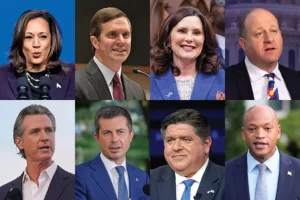
President Joe Biden’s shock July 21 announcement on X that he would not stand for reelection, months after securing enough delegates to be his party’s standard-bearer, left some questions about what this would mean for Vice President Kamala Harris.
The note thanked Harris near the end for “being an extraordinary partner” in pushing White House priorities but was otherwise silent on what this would mean for the Democratic Party’s presidential nod. The people in charge of Biden’s social media account quickly moved to end all speculation, posting about half an hour later, “My very first decision as the party nominee in 2020 was to pick Kamala Harris as my Vice President. And it’s been the best decision I’ve made. Today I want to offer my full support and endorsement for Kamala to be the nominee of our party this year.”
The last time an even remotely similar thing happened was in 1968 when President Lyndon B. Johnson dropped out of the running on the evening of March 31 in a televised address. Johnson administration Vice President Hubert Humphrey then secured the nomination and lost to another former vice president, Richard Nixon, in November.

This year, Biden was the only candidate who had something approaching a legal right to the party’s nomination. He held a commanding supermajority of the delegates who were pledged to vote for him in the first round. However, that right was not transferrable. He cannot do anything but urge them to vote for his preferred candidate. The convention that will be held in late August will technically be an open convention, though whip counts from state delegations have Harris as the clear favorite.
If those counts prove accurate, that will leave the bottom of the presidential ticket wide open. Democratic delegates and Harris’s team are looking at several different would-be candidates for vice president. These candidates fall into four broad categories: safe choices, swing-state anchors, balancers, and wild cards.
Safe choices
These candidates might be likened to Goldilocks’s choice of porridge, furniture, and bedding. They are known quantities that Harris, and Democratic delegates, might regard as “just right.” Names on this list include Transportation Secretary Pete Buttigieg, who has a national following, and Gov. Tim Walz (D-MN), who has put together a string of progressive victories and done a great deal to keep Minnesota from going Republican.
Swing-state anchors
There are certain states that Democrats simply need to win to have a chance at beating former President Donald Trump in November because of how the Electoral College math breaks down. These include Michigan, Pennsylvania, and probably Arizona. Thus Gov. Gretchen Whitmer (D-MI), Gov. Josh Shapiro (D-PA), and Sen. Mark Kelly (D-AZ) are getting serious consideration.
Balancers
Democratic politicians who can climb to the top in majority Republican states are rare. Putting one of them on the ticket would send a message to wavering voters of inclusion and ideological balance. That’s why Gov. Andy Beshear (D-KY) or Gov. Roy Cooper (D-NC) could end up getting the nod.
Wild cards
These are high-risk, high-reward nominations that have both drawbacks and possibly huge payoffs. For instance, Gov. J.B. Pritzker (D-IL) is something of a loose cannon, but he’s also a billionaire who could easily cut a $100 million check to boost the campaign.
The Constitution’s 12th Amendment does not allow both the president and the vice president to come from the same state. That would seem to rule out Gov. Gavin Newsom (D-CA), yet he remains one of the most successful Democratic politicians in the country.
Gov. Wes Moore (D-MD) is quite green, having first been elected in 2023 as Maryland’s first black governor. He is also relatively young, 45, with an interesting and varied background in the military, business, and philanthropy, and has a significant media profile. He has tentatively ruled out running, though he said he’d do whatever he can to get Harris elected.
CLICK HERE TO READ MORE FROM THE WASHINGTON EXAMINER
Gov. Jared Polis (D-CO) is somewhat out of step with his party, in a year when that might be a good thing. While much of his party was pushing COVID-19 lockdowns in 2020 and onward, Polis’s more libertarian instincts prevailed. He did what he could to keep his state as free as possible. Polis himself noted how improbable his nomination would be, saying on CNN, “Look, if they do the polling and it turns out that they need a 49-year-old, bald and gay Jew from Boulder, Colorado, they’ve got my number.”
Harris has reportedly requested vetting materials from several of those possible running mates, but this is an open convention. The delegates may feel like they’ve been accommodating enough already by voting for Harris when they were only pledged to vote for Biden. In any event, they remain free to do what they please rather than what is demanded of them.
Jeremy Lott is the author of The Warm Bucket Brigade: The Story of the American Vice Presidency.







